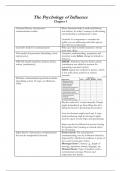The Psychology of Influence
Chapter 1
(Ancient) History of persuasive Plato: Interested only in truth and fairness,
communication studies not trickery. So today’s concept of advertising
and marketing is unimportant to him.
Aristotle: It is important to consider the
public you are addressing and what aspects
they find most important.
Lasswell’s model of communication Who says what in which channel to whom
with what effect.
Yale model of persuasion (describing a four- Attention, understanding, acceptance and
step process) retention come before change in attitude or
behavior.
AIDA(S) model (attention, interest, desire, AIDAS: Attention, interest, desire, action,
action, (satisfaction)). (satisfaction was added to account for
generating customer loyalty).
AIDA regards the recipient as passive, which
is not really done anymore in current
research.
McGuire communication-persuasion matrix
(describing at least 12 steps, see McGuire,
1989).
But the order isn’t a strict hierarchy. People
might immediately go from liking the ad to
liking the brand to purchasing the product.
Low involvement might need only 5 steps
until purchasing, high involvement might
need to repeat several steps until purchasing.
Steps can also be followed in reverse: buying
the product then forming an attitude about
its advertising.
Input factors of persuasive communication Source factor: The actual person
that can be manipulated/selected communicating, not the institution behind it.
Impacted by whether the audience is aware of
the source’s persuasive intent.
Message factor: Content; e.g., length of
message, repetition, humor, language, etc.
Channel factor: Type of medium used to
communicate message. Posture and
expression also matter.
, Receiver factor: Audience characteristics.
Communication-Persuasion matrix of Input communication variables and output
McGuire that combines input and output mediational steps that comprose the process
factors (see book chapter McGuire) of being persuaded.
Advertising can reach different effects; some are easier to reach than others.
Recall/recognition or likeability (positive attitude towards advertisement) does not guarantee
(purchase/health) behaviour.
Attenuated-effects fallacy Successfully influencing each output step
depends on the success at the previous steps.
Distant-measure fallacy Make sure that the ad actually passes all the
steps till step 10 (behavioral payoff).
Neglected-mediator fallacy An input element may increase your success
at one output step but decrease it at another
step.
Compensatory principle Intelligence level reduces persuadability, but
this can be compensated through attention
and comprehension.
Golden mean principle Apply too much fear, and the contents of
your message will be lost in it.
Apply just enough, and you’ll catch your
audience’s attention AND they process the
message well.
Situational-weighting principle The effect of an input element depends on
other input elements (e.g., if fear leads to less
thinking due to arousal and thus to less
comprehension, to counteract the last
message content can be made easier to
understand).
Role of non-governmental advertising Countries employ COA (code(s) of
regulators and Code of Advertising (COA). advertising) to make sure it remains fair and
ethical.
Chapter 2
Attitude object: the stimulus; the object of an attitude.
Attitudes are latent constructs.
Components of attitudes
• Cognitions (beliefs, opinions)
• Affect (feelings, emotions)
• Behavior (actions, conducts)
, The five characteristics
• They focus on an object, person, organization, or event.
• They are evaluative, either positively or negatively.
• They can be based on cognitive beliefs about the attitude object.
• They can be based on affective responses to the attitude object.
• They have repercussions for behavior towards the attitude object.
For sport-related or action-related activities, affective arguments usually work better.
Dual-process models
Differentiate between thorough information and superficial.
ELM: mutually exclusive rounds:
Someone must have time, ability, and motivation to follow central route.
Central route to persuasion seeks additional information.
Peripheral route: low involvement, influenced easily.
HSM (heuristic-systematic model): both central and peripheral routes can be taken at once.
Kahneman’s model:






